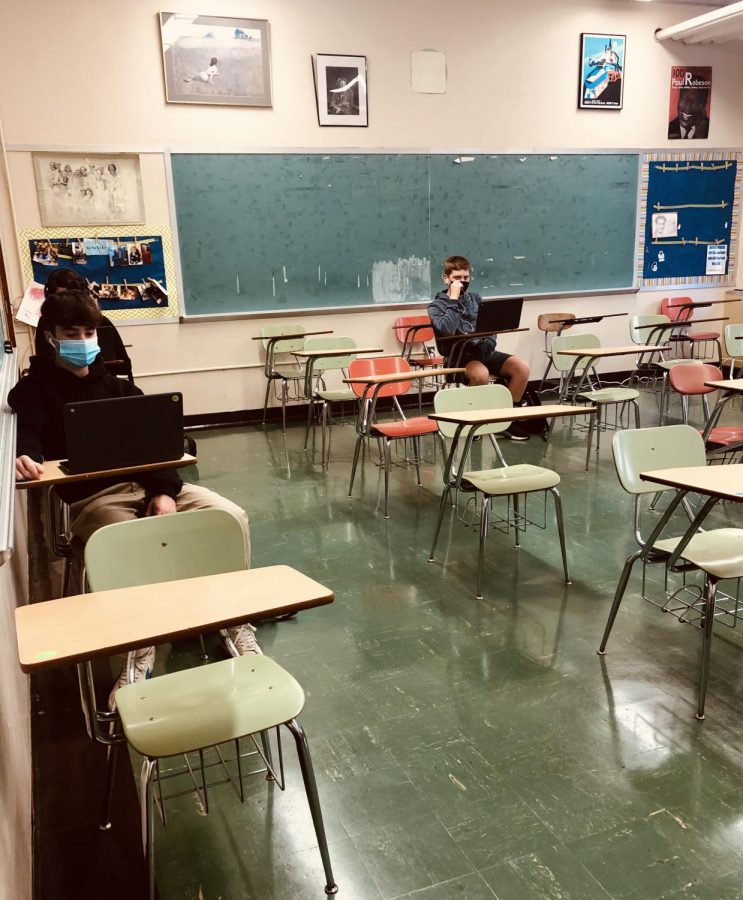Number of students choosing all-virtual option doubles
Photo Hi’s Eye Staff
English class with three students present in Cohort A. The rest of the class is at home learning remotely.
In recent weeks, WHS has seen a significant increase in all-virtual students. As of Hi’s Eye deadline, the number of students in Cohort C (all virtual) has jumped from 270 students to 566. Within Cohort C, there are 78 freshmen, 130 sophomores, 205 juniors, and 153 seniors, which equates to about 30 percent of the WHS student body.
According to Assistant Principal Warren Hynes, this increase began after the school’s temporary closure. Following the two-week shutdown, he believes students became more comfortable learning from home.
This was true for WHS Senior Mia Grogan. “After my second week when school went totally virtual, I knew I was going to be doing school completely at home after those two weeks passed,” Grogan said. According to Grogan, she was not happy with the social aspects of in-person learning.
Although the administration has stressed that there are social benefits to learning in-person, some teachers also share Grogan’s point of view. Spanish Teacher Rose Calimano said, “With one group in the classroom and one at home, [it is difficult to make] sure that all students can hear and see each other while being in different places. People are avoiding interacting [in school] as much as possible and as soon as they are done, they go home for the day. In my opinion, we are losing the sense of community.”
Senior Elizabeth Bielen, who recently switched to Cohort C, also noted this lack of socialization while in the building. Bielen said that due to mask mandates and social distancing requirements, it is difficult for students to interact with one another.
In addition to limited interaction with students, Bielen said that while at school she was unable to interact with her teachers as anticipated. Though the majority of teachers at WHS are in school four days a week, some students, like Bielen, have multiple teachers that are all-remote. Bielen said, “All but one of my academic teachers were remote. I would walk in, go to my desk, and stare at my teacher on the screen the entire period.”
Aside from social challenges, physical discomfort in the building has also been a driving force for the increase in Cohort C students. Senior Paige Eckard said that the reason she chose to switch was because she was not able to eat during the day and had concerns regarding the temperature in school. “All of the windows were [always] open and the fans were running, which was to circulate air, but it was too cold,” Eckard said. “I worried about what it would be like once the temperatures actually dropped, and thought I’d at least be in a comfortable environment from my desk at home.”
Though students have prepared themselves for cold conditions, there is hope for improvement. Each classroom has a unit ventilator that circulates fresh air. According to Principal Mary Asfendis, the district has installed ionization filters in unit ventilators that help purify the air and reduces the need for open windows.
Despite the fact that many students have been frustrated by their in-person experience, some still prefer the hybrid model. Sophomore Bella Hill said, “My experience in person has been pretty positive so far. People have been following the mask rules much better than I thought they would be, and it’s easier to concentrate when I’m sitting in a classroom.”
Like Hill, the WHS administration also sees great benefits to in-person learning. “Even though [being in school] is very different than it used to be, I still think there are social benefits,” said Asfendis. “I think there are benefits to structure and routine, and I think students are much more focused [at school].” Due to her belief in the value of in-person learning, Asfendis stated that the administration is reevaluating how and why students switch to Cohort C. Health concerns, Asfendis said, are one reason why a student would need to participate in all- virtual instruction.
Regardless of the continuous increase in students going all virtual, the hybrid system is here to stay for the foreseeable future. “What I have heard from many in our school community is that they understand the challenges presented by hybrid instruction and the great lengths our educators are going to make it work in this difficult educational environment,” Westfield Public Schools Superintendent Dr. Margaret Dolan said. “There is understandable frustration, but the district will continue to work to improve the hybrid experience.”

